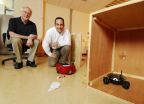(Press-News.org) Current energy technologies are not enough to reduce carbon emissions to a level needed to lower the risks associated with climate change, New York University physicist Martin Hoffert concludes in an essay in the latest issue of the journal Science.
Many scientists have determined that in order to avoid the risks brought about by climate change, steps must be taken to prevent the mean global temperature from rising by more than 2°C above pre-industrial levels. Current climate models indicate that achieving this goal will require limiting atmospheric carbon dioxide (CO2) concentrations to less than 450 parts per million (ppm), a level that implies substantial reductions in emissions from burning fossil fuels.
The present atmospheric level of CO2 is approximately 385 ppm, some 100 ppm above the pre-industrial level of about 280 ppm. It is expected to rise in future years.
"So far, efforts to curb emissions through regulation and international agreement haven't worked," Hoffert writes. "Emissions are rising faster than ever, and programs to scale up 'carbon neutral' energy sources are moving slowly at best."
Hoffert points to a pair of factors that show why current energy technologies are not sufficient to reduce carbon emissions to a level advocated by scientists.
One, alternative energy sources, such as solar and wind electricity, are not adequate to achieve "massive market penetration," which requires utility-scale systems that can store intermittent supplies of power until they are needed.
While Denmark and Norway have developed methods for this type of storage, these aren't "widely feasible in the United States, and other approaches to store power are expensive and need substantial research and testing," Hoffert contends.
Two, reliance on carbon-emitting fuels is once again growing.
"As natural gas and oil approach peak production, coal production rises, and new coal-fired power plants are being built in China, India, and the United States," writes Hoffert, a professor emeritus in NYU's Department of Physics.
Hoffert offers an array of approaches that would bring about new technologies while at the same time reducing the world's reliance on fossil fuels.
"Broad investment will be crucial to enabling basic research findings to develop into applied commercial technologies," he writes. "Carbon taxes and ramped-up government research budgets could help spur investments. But developing carbon-neutral technologies also requires, at the very least, reversing perverse incentives, such as existing global subsidies to fossil fuels that are estimated to be 12 times higher than those to renewable energy."
###
END
An innovative grouping of conservation scientists and practitioners have come together to advocate a fundamental shift in the way we view biodiversity. In their paper, which was published today in the journal Science, they argue that unless people recognise the link between their consumption choices and biodiversity loss, the diversity of life on Earth will continue to decline.
Dr Mike Rands, Director of the Cambridge Conservation Initiative and lead author of the paper, said: "Despite increasing worldwide conservation efforts, biodiversity continues to decline. If ...
The lure of greater profits elsewhere in the world may divert bio-pharmaceutical firms in developing countries from the creation and distribution of affordable drugs, vaccines and diagnostics for illnesses of local concern, undermining the health prospects of millions of poor people, experts warn.
And they call for a series of measures to bolster international support for continuing the success of firms finding homegrown solutions to immediate health concerns in developing countries.
In a commentary published by the journal Nature Biotechnology, researchers Rahim Rezaie ...
University of California, Berkeley, researchers have taken genes from grass-eating fungi and stuffed them into yeast, creating strains that produce alcohol from tough plant material – cellulose – that normal yeast can't digest.
The feat could be a boon for the biofuels industry, which is struggling to make cellulosic ethanol – ethanol from plant fiber, not just cornstarch or sugar – economically feasible.
"By adding these genes to yeast, we have created strains that grow better on plant material than does wild yeast, which eats only glucose or sucrose," said Jamie Cate, ...
NAIROBI (9 September 2010)—Greenhouse gas emissions caused by livestock operations in tropical countries—a major contributor to climate change—could be cut significantly by changing diets and breeds and improving degraded lands, according to a new study published this week in the U.S. Proceedings of the National Academy of Sciences. And as an added bonus, scientists found the small changes in production practices could provide a big payoff by providing poor farmers with up to US$1.3 billion annually in payments for carbon offsets.
"These technologically straightforward ...
Liquid water has interacted with the Martian surface throughout Mars' history, measurements by NASA's Phoenix Mars Lander suggest.
The findings, published in the Sept. 10 issue of the journal Science, also suggest that liquid water has primarily existed at temperatures near freezing, implying hydrothermal systems similar to Yellowstone's hot springs on Earth have been rare on Mars throughout its history.
These surprising results come from measurements Phoenix made in 2008 of stable isotopes of carbon and oxygen in the carbon dioxide of the Martian atmosphere. Isotopes ...
URBANA – In the search for the perfect crop for biofuel production, Miscanthus has become the darling to many. But in an effort to not be charmed by its enormous potential for biomass production, researchers at the University of Illinois are taking a careful look at the pros and cons of its behavior in the field.
A recent study analyzed water quantity and quality in plots of Miscanthus, switchgrass, corn, and soybeans and found that Miscanthus used substantially more water, but reduced the potential for nitrogen pollution to water bodies.
"We found that Miscanthus ...
A robot deceives an enemy soldier by creating a false trail and hiding so that it will not be caught. While this sounds like a scene from one of the Terminator movies, it's actually the scenario of an experiment conducted by researchers at the Georgia Institute of Technology as part of what is believed to be the first detailed examination of robot deception.
"We have developed algorithms that allow a robot to determine whether it should deceive a human or other intelligent machine and we have designed techniques that help the robot select the best deceptive strategy to ...
OTTAWA – September 9, 2010 --- New analysis of a landmark health survey by the University of Ottawa Heart Institute (UOHI) shows that 70% of Ontario adults are either overweight or obese, and have a strong prevalence of high blood pressure that could lead to heart attack or stroke.
The research, led by Dr. Frans Leenen of the Heart Institute's Hypertension Unit, adds new information to a limited amount of Canadian data on obesity and high blood pressure. The analysis further strengthens the link between high blood pressure and above normal Body Mass Index (BMI), a formula ...
AUSTIN, Texas—People are more likely to remember specific information such as faces or words if the pattern of activity in their brain is similar each time they study that information, according to new research from a University of Texas at Austin psychologist and his colleagues.
The findings by Russell Poldrack, published online today in the journal Science, challenge psychologists' long-held belief that people retain information more effectively when they study it several times under different contexts and, thus, give their brains multiple cues to remember it.
"This ...
It's no secret: the United States is in the thick of a "green trend." Increased awareness of and commitment to sustainability and improving the environment through reduced carbon emissions and energy use have led to more consumer demand for "green" products, including green construction. Even with the downturn in the housing market, a 2008 poll showed that 91 percent of registered voters nationwide would still pay more for a house if that meant a reduced impact on the environment.
The same is true for the commercial building industry, as construction companies prioritize ...




